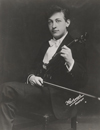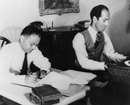All material found in the Press Releases section is provided by parties entirely independent of Musical America, which is not responsible for content.
Press Releases
Bright Shiny Things Releases Catherine Gregory and David Kaplan’s Vent, World Premiere Recordings of Works by Gabriela Lena Frank and Timo Andres

| FOR IMMEDIATE RELEASE September 8, 2023 |
Media Contact: Paula Mlyn A440 Arts (212) 924-3829 |
BRIGHT SHINY THINGS RELEASES CATHERINE GREGORY AND DAVID KAPLAN’S VENT, WORLD PREMIERE RECORDINGS OF WORKS BY GABRIELA LENA FRANK AND TIMO ANDRES, PLUS MUSIC OF DAVID LANG, SCHUBERT AND PROKOFIEV
Album marks Gregory and Kaplan’s duo recording debut
NEW YORK, NY–On September 8, 2023, Bright Shiny Things releases “magically mysterious”(New York Times) Australian-born flutist Catherine Gregory and “excellent and adventurous”(New York Times) pianist David Kaplan’s Vent [BSTC-0190]. The recording features flute and piano repertoire both traditional and contemporary, including two world premieres. The duo pairs Schubert’s Variations on “Trockne Blumen” and Prokofiev’s Flute Sonata in D with three contemporary pieces:the title track, David Lang’s Vent (1990); and world premiere recordings of Gabriela Lena Frank’s Five Andean Improvisations (2019) and Timo Andres’s Steady Gaze (2017). Both Gregory and Kaplan supply liner notes for the album, along with several guest writers: Frank supplies her own, composer Christopher Cerrone writes about his mentor David Lang, and scholar/pianist William Kinderman provides commentary for the Schubert Variations. Vent is available for pre-order here. (brightshiny.ninja/vent)
ABOUT THE MUSIC
Concerning the multiple meanings of their album title, Gregory and Kaplan explain:
“A vent is an opening, and ‘to vent’ is to express a strong emotion. Vent also means wind—the life force of sound on the flute. The title of this album, Vent, captures the energy and spirit of all the works on this album.”
In his notes for David Lang’s Vent, composer Christopher Cerrone says: “In its simplicity, it has one goal: Make two instruments one.” The first section of the work is built on tremolos in both instruments, with the piano bridging over the flutist’s breathing. The flute returns the favor in the slow middle section by providing the legato sustaining quality that comes less naturally to the percussion instrument. Cerrone continues: “Vent is notable as one of the earliest examples of Lang’s mature style—a bridge from his early experiments into a post-minimalism all his own—where instrumental color plays an equally important role as rhythm and pitches.”
Schubert’s Variations on “Trockne Blumen” take their theme from a song in his cycle Die Schöne Müllerin, but the variations develop the pathos-filled original theme into something much different. The “weary wanderer” protagonist of the cycle ends his life in suicide, but the variations take that as their starting point rather than climax, musically transcending the tragedy. As Kinderman puts it in the booklet notes: “If Schubert’s wanderer ultimately experiences suicide in the cool depths of the stream, this outcome symbolizes a redeeming embrace of nature in the closing E-major lullaby, as the stream protects the boy from the ravages of real life.”
Gabriela Lena Frank’s Five Andean Improvisations for flute and piano are what she calls “musings inspired by highland Peruvian/Bolivian musical motifs.” The traditional quena flute, for which the first movement is titled, has similarities to the more familiar Japanese shakuhachi. The second movement, “Ritmos del altiplano,” in which the piano is heard for the first time, uses a simple one-two rhythm in the piano part to accompany florid lines and ornamentation in the flute. The “Pinkillo” of the third movement is a small, light, silvery flute. “Chuta” is named after one of the most recognized Andean motifs, in which repeated notes proliferate. Finally, “Sombras” is a short tone poem about the islands of Lake Titicaca, where, as Frank says, “the stars are so bright they cast eerie and brilliant shadows, even at night.”
Timo Andres composed Steady Gaze as a wedding gift for Gregory and Kaplan in 2017. As the composer says, the piece “is a catalogue of hundreds of different ways—from offhand to effusive—of saying the same thing.” Built on a repeating chord progression, the piece transforms gradually through micro-variation, with the flute part weaving its way around the piano part. The work is something of a psychological center to the album repertoire: Andres often cites Schubert as an influence; Kaplan observes the influence of Prokofiev as well, “especially in the brighter side of Steady Gaze’s chiaroscuro”; and David Lang was among Andres’s mentors at Yale. This marks the first time Lang and Andres are featured together on the same album.
Gregory says of Prokofiev’s Flute Sonata in D major: “I have long imagined this iconic Sonata opening a window onto a wide, wintery vista. Written against the backdrop of the Second World War in 1942-43, the work seems to me to show Prokofiev expressing a certain nostalgia for a lost homeland ravaged by conflict and trauma.” A familiar staple of the flute repertoire, the work showcases all facets of the instrument’s expressive potential on a large canvas, as Gregory sums up: “Its symphonic scale, vast palette of color, and emotional breadth ennoble the flute.”
TRACK LIST
David Lang
1 Vent
Franz Schubert
Variations on "Trockne Blumen," D. 802
2 Introduction
3 Thema
4 Variation I
5 Variation II
6 Variation III
7 Variation IV
8 Variation V
9 Variation VI
10 Variation VII
Gabriela Lena Frank
Five Andean Improvisations
11 I. Quena
12 II. Ritmo del altiplano
13 III. Pinkillo
14 IV. Chuta
15 V. Sombras
Timo Andres
16 Steady Gaze
Sergei Prokofiev
Flute Sonata in D major, Op. 94
17 I. Moderato
18 II. Scherzo
19 III. Andante
20 IV. Allegro con brio
ABOUT THE PERFORMERS
The duo of Australian flutist Catherine Gregory and American pianist David Kaplan have performed together since 2014. Their recital programs creatively intertwine repertoire from the Baroque to the present day, with several pieces being written especially for them, including Timo Andres’s Steady Gaze and a new major work commissioned from Christopher Cerrone in the 2024-25 season. Both passionate about connecting directly with communities through music, they often perform together as Core-Artists of Decoda, the affiliate ensemble of Carnegie Hall, which aims to build a “more compassionate and connected world” through chamber music. Catherine and David have also been married since 2017 and reside in Los Angeles. Outside of music, they enjoy cooking, hiking, and attending art museums together.
Catherine Gregory is the winner of the 2018 Pro Musicis International Award, and has given recitals and chamber music performances at Carnegie Hall, Caramoor, with the Chamber Music Societies of Philadelphia and Lincoln Center, Camerata Pacifica, and the Southern Cross Soloists. She has toured internationally with the Orpheus Chamber Orchestra and the Australian Chamber Orchestra, and has played numerous cycles as guest principal flute with the Malaysian Philharmonic Orchestra. Catherine’s current project, Just Breathe, embodies her creative spirit as a commissioner of new music and artist citizen: it is both a performance of new commissions from leading composers such as Clarice Assad, Viet Cuong, and Juhi Bansal, as well as a series of interactive performance workshops for cancer patients, providers and caregivers that explore the intersection of breath and music. She serves on the faculties of the UCLA Herb Alpert School of Music and The Colburn School, and has given masterclasses and residencies at top music schools all over the world, including The Tianjin Juilliard School, the Curtis Institute of Music, the Yong Siew Toh Conservatory in Singapore, and the Guildhall School of Music and Drama in London. Catherine graduated with first-class honors from the Queensland Conservatorium, Griffith University (Australia) as a student of Gerhard Mallon, and came to the United States in 2009 as a Fulbright Scholar to pursue her Artist Diploma with Alberto Almarza and Jeanne Baxtresser at Carnegie Mellon University. She is also an alumna of Ensemble Connect, the innovative post-graduate fellowship of Juilliard and Carnegie Hall. Catherine plays on a Nagahara flute.
David Kaplan has consistently drawn critical acclaim for creative programs that interweave classical and contemporary repertoire, often with newly commissioned works. He has given recitals at the Ravinia Festival, Washington’s National Gallery, Strathmore, and New York’s Carnegie and Merkin Halls. Kaplan’s New Dances of the League of David, mixing Schumann with 16 new works, was cited in the “Best Classical Music of 2015” by The New York Times. His Quasi una Fantasia project pairs commissions from Anthony Cheung, Christopher Cerrone, and Andrea Casarrubios with works from Couperin to Beethoven to Saariaho, all linked by improvised preludes and transitions. Kaplan has previously recorded for Naxos and Marquis Records, as well as for Nonesuch as part of his longstanding duo with pianist/composer Timo Andres. As concerto soloist, he has appeared at the Barbican Centre with the Britten Sinfonia and Das Sinfonie Orchester Berlin in the Philharmonie, and in 2024 makes debuts with the Symphony Orchestras of Hawaii and San Antonio. Kaplan serves as Assistant Professor and Inaugural Shapiro Family Chair in Piano Performance at the UCLA Herb Alpert School of Music, where he has taught since 2016. A native of New York City, Kaplan began piano studies with Miyoko Lotto. He earned his Bachelor of Arts at UCLA, studying with Walter Ponce, and then completed MM and DMA degrees at the Yale School of Music, where he was a student of Claude Frank. Kaplan also studied conducting with Lutz Köhler at the University of Arts in Berlin, under the auspices of a Fulbright Fellowship. David is proud to be a Yamaha/Bösendorfer Artist.






 FEATURED JOBS
FEATURED JOBS

 RENT A PHOTO
RENT A PHOTO


